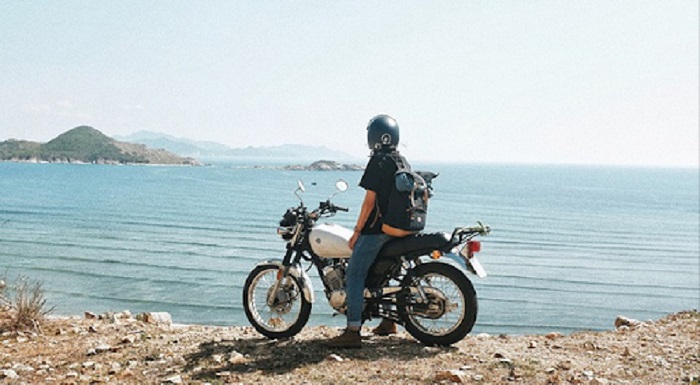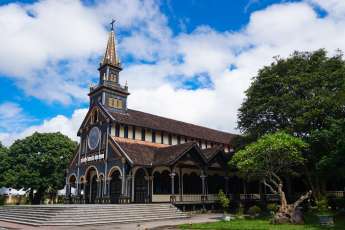
Plan your motorcycle trip to Vietnam
- on Jul 31, 2023 By: Ngoc Nguyen
Insane, risky, but great fun. This is what you will hear about motorcycle trips in Vietnam. But, how else will you go on your adventure, connect with the countryside and the people, and get to know this amazing yet frenetic country? Start with a bucket of courage and get ready for an exhilarating ride of a lifetime!
One in four people in Vietnam owns a registered motorcycle (including scooters). You will therefore be in good company with 37 million vehicles registered in this Southeast Asian country. Additionally, there are over 330,000 square kilometres of land to explore. If the Top Gear TV guys could do it, maybe you can too?
Without further ado, here is everything you need to know to start your trip to Vietnam!
1. Stay safe while traveling in Vietnam by motorbike
Be on the lookout for petty theft in tourist areas and markets on your Vietnam motorbike tour. There is also an aggravated risk of theft in major cities such as Hanoi, Ho Chi Minh City, and Danang. It should also be remembered that Vietnam provides severe penalties for drug-related offences.

Another travel risk is, you guessed it, traffic accidents that often happen in Vietnam. For some reason, crashes also draw huge crowds.
2. Plan your motorcycle trip to Vietnam
2.1. When to travel
You probably don't consider yourself a fair-weather rider, but the rainy season from June to December will dampen your motorcycling spirit. This is the time of floods, flash floods and typhoons. Considering that some roads and infrastructure might already be a bit more worn-out, you wouldn't want to risk getting stuck. Check out our handy weather map to find out when is the best time of year to travel to Vietnam.
2.2. Get a visa
First, go to the nearest Vietnam embassy or consulate to get your visa. If you opt for private online visa services and request travel agents for “visa on arrival” approval letters, you risk your private information becoming public. Make sure your passport is still valid for six months when you apply for your visa.
2.3. Driver's license
Previously, to drive a motorbike or car in Vietnam, you had to have a Vietnamese driver's license (which was not issued to tourists). However, since 2014, Vietnam has recognized international driving licenses which can be obtained in your home country before traveling to Vietnam. This makes planning your motorbike trip in Vietnam much easier!

However, be aware that some motorbike rental companies in Vietnam will lend you a vehicle even if you don't have a license, claiming that “the police rarely stop you unless you do something wrong”. Are you lucky and thinking of driving your motorcycle without a license? Not worth the risk of being fined.
2.4. Travel insurance is a must!
There are many reputable insurers out there, but check the fine print to find out if they will cover you when traveling on a motorcycle. Be sure to check it out. Most policies state that they will cover motorcycles as long as a licensed driver rides them legally. Sort it out before getting on your bike!
The policies you will need are personal medical insurance - which covers you in accidents and when you are injured - and liability insurance - which covers others and things you injure/damage. Medical facilities and care vary in Vietnam, even at foreign private medical clinics in the main cities like Hanoi, Ho Chi Minh City, Vung Tau, and Danang. You should expect to pay fees to the doctor or hospital before they treat you, including in an emergency. Health problems that occasionally arise in Vietnam include water- or food-borne diseases, parasitic and other diseases, including HIV/AIDS, hepatitis, rabies, typhoid, tuberculosis, and meningitis. Protect yourself from mosquitoes as they can spread the Zika virus, dengue fever, malaria, and Japanese encephalitis.
2.5. Where not to go and what not to do
Authorities get a little tricky if you're traveling near military bases (don't take photos either) and there are also travel restrictions in parts of the central highlands and some border areas. They’re all for good reason as there are landmines and unexploded ordnance in the old battlefields!
Avoid gambling dens as gambling is illegal except in government-licensed casinos. Speaking of money, you will get a better conversion rate if you exchange your currency for Vietnamese dong before you leave home. Also, let your bank know you're traveling to Vietnam so they don't inadvertently stop your card.
If you take prescription drugs, don't expect to be able to stock up in Vietnam.
2.6. Staking out a route
How long are you planning to visit Vietnam? You could comfortably do the whole country in a month, but if you're short on time, consider focusing on a particular section.
Most motorbike tour companies offer standard private tours, premium tours, and special event tours which are a great fun way to enjoy the many sights and sounds of Vietnam.

When you depart from one of the big cities, be prepared for traffic jams, a chaotic pace, and overwhelming smoke. In Hanoi, day trips ranging from one to four days are a good idea to help you navigate the city like the locals do. It’s a great option for first-timers who want to visit just the city or explore surrounding areas such as Bac Ninh Province or World Heritage-listed Halong Bay. You will see pagodas, 300-year-old villages, and waterfalls and experience winding mountain roads. A Ho Chi Minh City motorbike tour that you can do in half a day takes you to French colonial buildings, the market, alleys, and Chinatown.
2.7. What to bring with you
Although you can buy and rent them, it is recommended (for quality) that you bring your helmet, riding gloves, decent protective boots, a summer riding jacket (with padded elbows), glasses, a smartphone, and an all-weather backpack as a minimum. For starters, you must wear a helmet when riding a motorbike in Vietnam - it's the law - including when you're a passenger. If you don't want to bring your own, once in Vietnam, it is recommended to visit a motorcycle dealer to find a certified helmet, especially a full-face helmet. Lightweight pants that are breathable and have padded hips and knees are also practical. If you're joining an organized tour, their support vehicle can carry the gear you won't need on your motorcycle.
Once you've purchased a motorbike in Vietnam, invest in a chain and padlock as well as octopus straps/bungee cords to secure your backpack. Consider getting emergency lighting like a strong bike light - you never know if you'll be caught off guard and your lights will fail.
3. Choose the vehicle
First, decide if buying or leasing a motorcycle is right for you. This decision will depend on the time you will spend in Vietnam; renting is often easier because you don't have to worry about selling the bike at the end of your trip. The most popular motorcycles are the Honda Win and the Russian Minsk – two old models. You will see a lot of 100cc or 110cc motorcycles with Honda badges, but they may be Chinese copies and only cost US$250. We also suggest visiting major cities' riding areas for “bike for sale” flyers. It is recommended to go for a 250cc which will give you a decent grunt while still being nimble enough to navigate in water on roads and along unpaved roads.

Most travellers start their trip in Ho Chi Minh City and try to sell their vehicles in Hanoi. However, you should consider going the other way in order to have a buyer's market to get your wheelset in Hanoi and sell them in Ho Chi Minh City. Keep in mind that Hanoi's roads have five million motorbikes, which could explain why the government is considering banning motorbikes there from 2025.
4. Advice on the road
You'll be able to refuel when you need it and you'll travel around 40 kilometres for every litter of fuel. If your vehicle needs tweaking or more serious repairs, look for a "Xe May" sign or the Honda Motorcycle logo. Keep your machine running smoothly by greasing the chain every 300 kilometres, checking tire pressure, and changing the oil every 1,000 kilometres.

Supposedly, vehicles drive on the correct side of the road, but their concept of a "lane" may be different from yours. Be sure to let trucks, army jeeps, and buses pass. The maximum speeds you will be able to reach are 100 kilometres per hour on some stretches of highway but come with the idea that travelling in Vietnam can be very slow and you should take your time. A good yardstick, especially when you're in urban areas, is to assume you'll be going about 30 kilometres per hour. You might think it's optional for drivers to obey traffic lights - that's how Vietnamese drivers operate. Try to reach your next destination before dark and avoid driving in the dark as there are obstacles you may not see, such as potholes.
When travelling, ask locals about the road conditions ahead. On the open road, there are plenty of food options along the way (but stock up on bottled water) and reasonably priced accommodations where you can keep your motorbike and gear safe.
Related articles:
>> Top 8 destinations to see golden rice season in Vietnam
>> When and where to surf in Vietnam?
>> Top 10 adventure activities in Vietnam
>> The most beautiful rivers in Vietnam: Activities not to be missed
Comment
Other Blog
Categories
Latest News
on 31 Dec, 2025
on 31 Dec, 2025
 Español
Español Français
Français







.jpg)

.jpg)










Morgane Ter Cock
on Dec 18, 2025HerbertPhomaMS
on Oct 19, 2025Lilyan Cuttler
on Oct 15, 2025Avenue17XC
on Sep 14, 2025Avenue18JL
on Jul 21, 2025